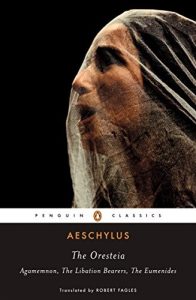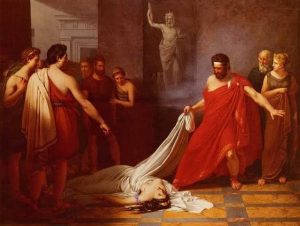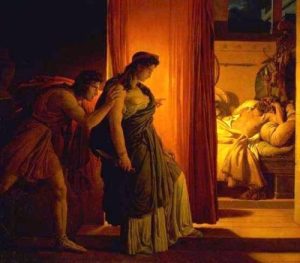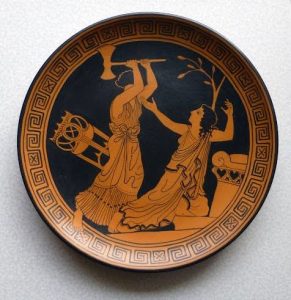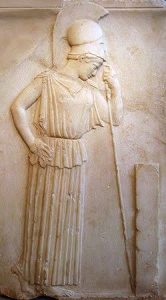A
VINDICATION OF THE MONSTROUS MYSTIQUE : THE TROUBLE WITH PROCREATION, AND
FEMINIST JURISPRUDENCE IN AGAMEMNON
“A
shudder in the loins engenders there
The
broken wall, the burning roof and tower
And
Agamemnon dead.
Being so caught up,
So
mastered by the brute blood of the air,
Did she
put on his knowledge with his power …?”
–
Leda and the Swan, W.B.Yeats
“We must kill the false woman who is preventing the live one
from breathing”
–
The Laugh of the Medusa, Helene Cixous
Aeschylus’ Agamemnon
(5th Century B.C.), part of the Oresteia (Ὀρέστεια) trilogy, is augmented as a historical artifact
that is domineered by legal imagery. Its mythopoesis is hegemonized by the
Trojan War, riding roughshod over the theft of Helen and ending with the
adversarial counter-prosecution by Athena, under the supervision of Zeus. The
homicidal audacities in the narrative are not coincidentia oppositorum but, contrastingly, they confront combats
: of Olympian over chthonic (Divinity), Greek over Barbarian (Culture), and
male over female (Society). Antiquarian women have perforce been leading at the
helm of Western liberalization, with Latinate samaritans like Camilla,
Semiramis, Artemisia and Cleopatra directing their motherlands to warfare.
Aiming to juxtapose such a monstrous androgyne with the myth of matriarchy,
Orestes assassinates his mother, the deceptive and tragic wife Clytemnestra, in
open alliance with Apollo.
Agamemnon
Clytemnestra, Twilight of the Matriarch
J J Bafochen asserts in ‘Mutterrecht
und urreligion’ (1967) that Greek heroes like Herakles and Theseus laid
their crusades foremost against the feminine Amazonomachy figures, who were
deemed to be feminine (earthborn) beasts. Joan Bamberger elaborates on this
hypothesis, proclaiming that female sexual dimorphism (unbridled sexual
transgressions) acted as a social charter for ‘chaos and misrule’. Since
Clytemnestra performs the gynocratic slaughter as a domestic vendetta (ruling
on behalf of husband-monarch), her act is equated to the Danaids who slay their grooms on the wedding night. At the same
time, her adulterous lover Aegisthus vociferates as the powerless lion and the
chorus calls him an ‘effeminate woman’.
He is ironically destined to a similar fate as that of Agamemnon who confessed
to his sensual weakness for Cassandra, the concubine from Troy. In a reversal
of roles, reminiscent of Hercules’ enslavement to Queen Omphale, the Rule of Women pioneers as a political
issue here, in a misogynistic progression from Althaea (mother) & Scylla
(daughter) to Clytemnestra (Wife).
Pierre-Narcisse Guérin. Clytemnestra
hesitating before stabbing Agamemnon, 1817. Louvre, Paris.
Clytemnestra kills Cassandra
Outraged by the abhorrent extermination of her daughter
Iphigenia, the female havoc ripples shockwaves on Argos and subsequently to the
Universe. Furies, the schizophrenic
products of Clytemnestra’s vengeful dreams, and the virginal Erinyes, transmutations of her blood
guilt – all act in cognizance as Daughters of the Night, delegating as paides apaides (‘children who are not
children’). Her negative sexuality
marshals towards a primordial malevolence, hysterically attempting to liquidate
even her own son in the guise of the Serpent:
Who is so childish or bereft of
sense as to get his heart
excited by the sudden news of the
beacon
…It’s just like a woman to believe a
thing before it is clear (479-84)
The Remorse of Orestes (1862). W-A. Bougereau.
Bamberger shows that puberty
initiation rites detach the pubescents from the care of natal maternity and
regroups them with mature males, usurping women’s sovereign rights. For
Orestes, his peripheral exile during childhood and fortuitous return during
puberty – both are undertaken as consequences of maternal savagery. Moreover,
his revenge as the lawful successor to the throne inevitably causes a
separation from his mother, who is first tried as a wife (“For it is not the same thing that a noble man die, with
God-given sovereignty, at the hands of a woman at that”) and then as a Mother, the archetype of vindictive frisson. Be that as it may,
‘a state cannot be changed without first being annihilated’ (Eliade 1958). In
the play, the succession myth is situated alongside the ‘final oracular
beginning’, i.e., destruction is transformed into creation by the female, in
order to attain peace.
Philippe Auguste Hennequin, 1762-1833
The Erinyes’ impulse to guzzle, engulf and paralyze Orestes
in the darkness of Hades is a transpersonalized endeavor at female retaliation.
As the dragon of retributive justice cannot be slain, it must be tamed.
Pertaining to a pacifying reprisal in the drama, the demonic performativity
accentuates a pathway for a socio-collective, non-violent, persuasive trial (Peitho). Contrary to Aristophanes’s Thesmophoriazusae, where the female is
nude (pornographic) and mute, Clytemnestra refuses staticity and demands divine intervention from
Zeus, Ate and the daimon. A
heterogenetic spectator is aware that she inclines towards criminality only as
a susceptible defense against mutual
recriminations.
The pensive Athena
Her ordinance (horos)
and political gallantry (krotos) is
announced by a masculine (provocative) crudity of language. Helen P. Folly
argues that her ontological lack of shame preserves the fires of Troy’s
demolition and frames the battalion metaphorically within the house of Atreus.
Owing to her speech-act, she exhibits a bravura that unapologetically reveals
the predicament of the defeated survivors (Gagarin 1976). For her, the ostracized gender must speak for
the afflicted. Indeed, she is bound to adopt a male rhetoric (bilingual paradoxes),
commit to scandalizing honesty and overthrow deferential gnomes, yet, as
Goldhill argues, ‘her weapon is a net, not a sword’.
Rape of Cassandra, the Prophetess
Like Eumenides,
conjugality (patriarchal unions) rigorously subverts biophysiological roles,
inasmuch as Athena was born from Zeus’ head. Concurrently, Aristotle
demonstrates that even though the fecund body (soma) withholds the pneuma
(divine seminal fluid), its soul and essence (ousia) are produced from the male
brain. Therefore, advancing the myth of virginal maternity, the Apollonic
theogony also appropriates female embryology, eradicating the last identity
that she could call her own.
Orestes slaying Aegisthus and Clytemnestra
2nd Century AD, State Hermitage Museum, St. Petersburg
Conclusively, it is intuitive on the part of Clytemnestra
that she considers Cassandra to be her own alter-ego, attributing her active
sexuality onto her insane prophecy.
Within the paraphernalia of double standards, her epistemological integrity can
be perceived as monstrous to the orthodox Elders, for she repudiates the way
they call Helen a man-destroyer. She also reformulates the inheritance law,
placing her daughter into direct lineage, while the Furies prevent Orestes from
ascending. Nevertheless, the animosity towards female terror, and its
absolutist affirmation is the proof that Greek tragedies were insubordinately
modern for its time and the female signification of the polis was refurbished with each instance of monstrous valor.
Works Cited:
Aeschylus. Oresteia:
Agamemnon. University of California Press, 2014.
Creed, Barbara. The
Monstrous-Feminine: Film, Feminism, Psychoanalysis. Routledge, Taylor &
Francis Group, 2015.
DesBouvrie, Synnøve. Women
in Greek Tragedy: An Anthropological Approach. Norwegian Univ. Press, 1992.
Foley, Helene P. Female
Acts in Greek Tragedy Female Acts in Greek Tragedy. Princeton University
Press, 2009.
McClure, Laura. Spoken
like a Woman: Speech and Gender in Athenian Drama. Princeton Univ. Press,
2010.


